Summary:
- The decline in the Conference Board Leading Economic Index below -8.0% signals an impending recession.
- Walmart has incorporated automation within its stores to improve operational efficiency.
- The appearance of symmetrical broadening and ascending broadening wedges highlights considerable market volatility.
- The appearance of an inside bar and a breakout above it suggests that the price is likely to continue moving upward.

bgwalker/iStock Unreleased via Getty Images
In the face of potential recession and economic uncertainty, Walmart Inc.’s (NYSE:WMT) resilience and adaptability position the company as a favorable choice for investors seeking stability. Despite inflationary pressures, Walmart’s cost-cutting and automation strategies enable the company to maintain low prices and protect profit margins. Historically, the company has demonstrated consistent growth during previous recessions, further strengthening its appeal as a recession-resistant investment.
However, investors must consider market risks, such as changing consumer behavior and inventory management challenges, which may impact Walmart’s financial performance. While technical analysis suggests a bullish outlook, heightened market volatility and the emergence of broadening wedge patterns indicate potential price movements. Investors can buy shares in the market to take advantage of potential future growth. Ultimately, Walmart’s proven track record of navigating economic turbulence and its commitment to maintaining a low-cost, value-driven approach make it an attractive option for investors seeking stability amid uncertain economic conditions.
Recession Warning and Economic Indicators
As the Personal Consumption Expenditure (PCE) increased from 0.91% in April 2022 to 5.43% in February 2022 and interest rates remained low, the Federal Reserve took action and began increasing interest rates in March 2022. As of now, interest rates have steadily risen to 4.65%, resulting in a decrease in core PCE inflation to 4.6% – the same level as from October 2021. This indicates that inflation has not increased further after the rise in interest rates. In addition, the index of sticky prices has dropped to 4.8% for the 12 months to March 2023 and is growing at an annualized rate of 4.6%.
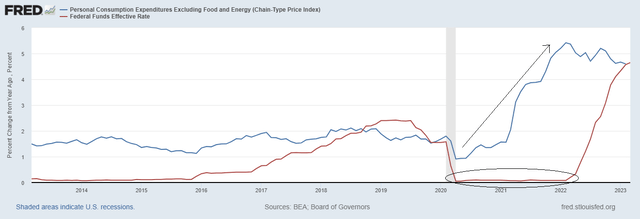
Personal Consumption Expenditure (fred.stlouisfed.org)
The stabilization of core PCE inflation at 4.6% and the declining sticky price index suggest that inflationary pressures are easing, which may lead to increased consumer confidence and spending. Walmart’s value-oriented business model, coupled with its economies of scale, positions it to attract budget-conscious customers and maintain lower prices during times of high inflation. As interest rates rise, Walmart’s adaptability and investments in e-commerce and omnichannel strategies will likely enable the company to protect its margins and retain customer loyalty, further bolstering its prospects in an evolving market landscape.
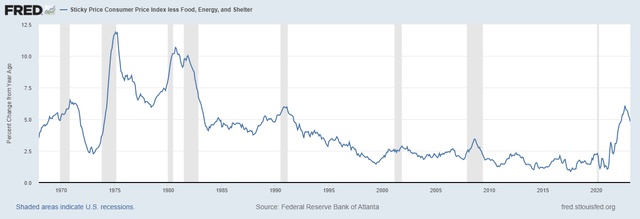
Sticky Price Index (fred.stlouisfed.org)
The chart below illustrates the negative real interest rates resulting from the difference between the Federal funds’ effective rate and PCE. This situation is bullish for Walmart’s stock price as the negative real interest rates stimulate borrowing and spending, which in turn leads to increased demand and potentially higher inflation. While a recession might alleviate some inflationary pressures, the true risk lies in the speed of inflation recovery if the Fed continues to maintain negative real interest rates. If managed poorly by the Fed, this environment could trigger an uncontrolled surge in inflation that could be detrimental to the economy. However, Walmart’s resilience and adaptability in the face of economic challenges position the company to benefit from increased consumer spending, potentially driving up its stock price.
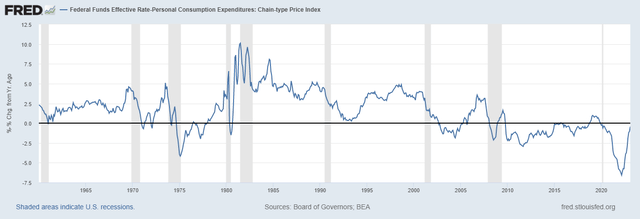
Real Interest Rates (fred.stlouisfed.org)
The Federal Reserve’s decision to raise interest rates in an effort to combat soaring inflation has led to a negative Treasury yield curve, as depicted in the chart below. This negative value of the Treasury yield curve hasn’t been observed since the 1980s, which signals that the economy is nearing a recession. However, Walmart may stand to benefit from these economic conditions, as the company is known for its ability to thrive in recessions due to its competitive prices and diverse product offerings. As consumers become more price-conscious during economic downturns, Walmart’s value proposition becomes increasingly attractive, which bolsters its performance despite the broader financial landscape.
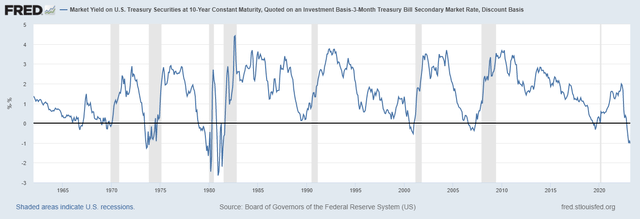
Treasury Yield Curve (fred.stlouisfed.org)
The Conference Board Leading Economic Index’s decline to -8.1% serves as yet another indicator of an impending recession, which may have consequences for Walmart. Historical data reveals that readings below -5% have consistently preceded recessions over the past six decades, suggesting a challenging economic landscape ahead.
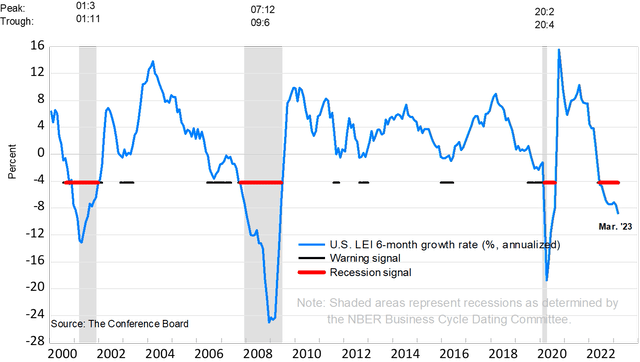
CB Leading Economic Index (conference-board.org)
Technology Advancements and Automation
Walmart has been making significant investments in automation to enhance operations, reduce costs, and boost profits. According to the company’s forecasts, approximately 65% of Walmart stores will incorporate automation in the coming years. This strategic move is expected to reduce average unit costs by as much as 20% while increasing the sales growth rate over the next five years. By focusing on automation, Walmart aims to strengthen its position against competitors such as Amazon.com, Inc. (AMZN) and capture a larger share of the online market.
Currently, e-commerce accounts for 13% of Walmart’s sales, with digital sales experiencing a 17% increase in the last quarter of the previous year. The company’s automation strategy will improve the efficiency of the order-taking process, reduce steps, accelerate service, and lower costs, ultimately providing Walmart with a competitive edge in the market. Despite a high inflation environment, this strategic move has also contributed to a 3.83% increase in Walmart’s profit margin, as depicted in the chart below.

Walmart recently announced the layoffs of 2,000 employees as automation adoption increases, which will further boost the company’s profitability. This change will also impact the revenue per employee, indicating increased productivity within the company. The chart below compares the revenue per employee for both Amazon and Walmart, showing a clear increase for Walmart in 2022.
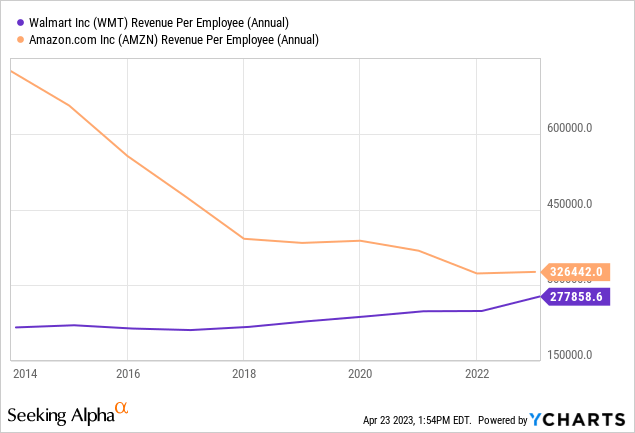
In recent years, Walmart has made notable improvements, such as introducing grocery pickup stations at thousands of stores, launching the Walmart+ membership subscription, expanding its marketplace and advertising business, divesting underperforming international businesses, and enhancing operations at Sam’s Club. These efforts have resulted in consistent sales growth and market share gains, transforming Walmart into a modern omnichannel retailer.
During challenging economic times, Walmart has proven to be a reliable choice for investors, thanks to its economies of scale, everyday low prices, and a significant portion of its revenue coming from essential items like groceries. As a result, the company is often considered recession-proof and has recently outperformed the market.
Heavy Volatility within a Bullish Trend
The fundamental outlook for Walmart is bullish, and this is further supported by technical analysis, which also indicates a strong bullish price structure. Over the past 50 years, Walmart’s quarterly chart has consistently demonstrated a robust bullish trend. It’s worth noting that the stock price has experienced increasing volatility over time, driving prices to new highs.
A significant price consolidation occurred between 2000 and 2011, culminating in a breakout at $48 in October 2011. During this period, the price exhibited bullish behavior, as each decline was promptly followed by a recovery – a strong indication of bullish momentum. Following the breakout, the stock price surged, reaching a high of $76.21 before correcting back to the $48 level. This correction presented the biggest buying opportunity in Walmart’s history, ultimately propelling the price to an all-time high of $159.23 – a staggering 231.25% increase from the October 2015 lows of $48.07.
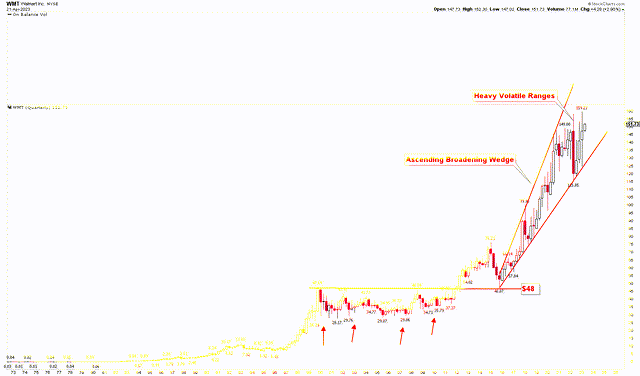
Walmart Quarterly (stockcharts.com)
The considerable price increase was accompanied by substantial volatility, giving rise to an ascending broadening wedge pattern on technical charts – a sign of significant market uncertainty. This uncertainty has persisted, as evidenced by the sharp decline from a high of $158.25 to $115.85 in the second quarter of 2022, followed by a subsequent rally. As market volatility continues to rise, the stock price is likely to surpass previous all-time highs. Consequently, investors may consider buying strategies for Walmart stock.
Walmart Adoptability During Recession
As the United States faces an impending recession, it is insightful to examine Walmart’s response to the previous three recessions, as illustrated in the chart below. The chart reveals that Walmart’s stock price consistently rose during recessions and experienced significant growth following these periods.
The early 2000s recession, which spanned eight months, was after the largest recession in US history during the early 1990s. Throughout the 1990s, the US enjoyed its longest economic growth period to date. However, the collapse of the speculative dot-com bubble decreased business outlays and investments and the tragic events of September 11th brought this era of prosperity to an end. Despite these considerable disruptions, the resulting recession was relatively brief and mild. Walmart navigated this challenging period by focusing on offering low prices across its product lines to appeal to cost-conscious consumers, and by increasing efficiency through cost-cutting measures and expense reduction.
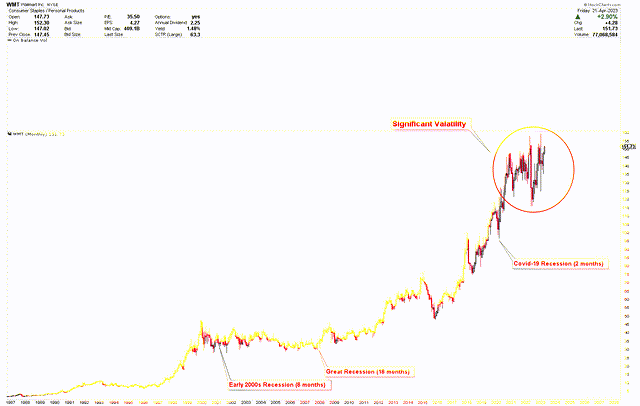
Walmart Monthly Chart (stockcharts.com)
On the other hand, the subprime mortgage crisis triggered the collapse of the US housing bubble and had extensive repercussions on the global economy, including skyrocketing oil and food prices. This crisis caused the failure or collapse of major US financial institutions as well as upheaval in the automobile industry. In response, the government enacted a historic $700 billion bank bailout and a $787 billion fiscal stimulus package. Amid such challenging economic conditions, Walmart’s low-price strategy and broad product offerings became increasingly attractive to consumers seeking to maximize their budgets. Consequently, the company’s revenue growth remained linear, with revenues of $377.02 billion and $404.25 billion in 2008 and 2009, respectively, while its stock price surged considerably higher from its 2007 low. Despite the economic challenges, Walmart maintained a return on equity of at least 20% during the same period and even expanded by opening over 150 superstores in the US and nearly 500 units outside the US.
During the brief two-month Covid-19 recession in 2020, Walmart’s stock price experienced a remarkable increase, soaring from $115.85 to $159.23 as the company maintained consistent positive revenues and profitability. This period saw a significant rise in demand for groceries and consumer staples, fueled by a heightened unemployment rate and Americans’ search for affordable items or panic buying due to concerns over supply chain shortages. Walmart impressively reported a 9.7% growth in comparable-store sales and generated more than 235,000 new jobs to support those impacted by pandemic-related layoffs. Furthermore, the company established 139 COVID-19 testing sites in its parking lots and improved its online and contact-free shopping capabilities, responding to a 74% revenue increase in its e-commerce segment compared to the previous year.
In light of Walmart’s proven resilience and adaptability during past recessions, the company appears well-prepared to confront the upcoming recession and continue serving its cost-conscious customers effectively.
Key Takeaways for Investors
To gain further insight into the bullish outlook for Walmart, it is helpful to examine the same pattern in the quarterly chart using the weekly chart, which displays an ascending broadening wedge as shown in the chart below. Notably, the substantial volatility observed in the quarterly chart forms a symmetrical broadening wedge. The presence of a symmetrical broadening wedge within the ascending broadening wedge highlights significant volatility and suggests the potential for a strong move in either direction. Additionally, an inside bar has emerged on the chart and was broken to the upside. This upward break of the inside bar indicates a likelihood that the price will continue to rise.
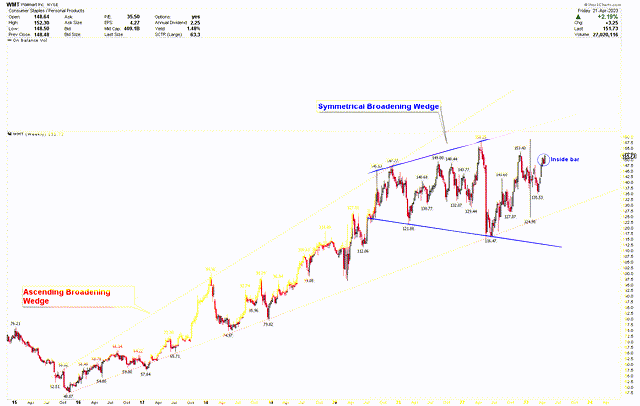
Walmart Weekly Chart (stockcharts.com)
Long-term investors may consider any correction as a buying opportunity. However, the break of the inside bar signals that the price may continue its upward trajectory, prompting investors to enter the market and anticipate higher prices as the recession looms. The first target of this bullish move will be the trend line of the symmetrical broadening wedge.
Market Risks and Challenges
During the early stages of the pandemic, Walmart experienced significant growth as it was deemed an essential retailer. However, as the economy reopens and consumers become eager to spend time away from home, the company faces challenges in adapting to rapidly changing consumer behavior.
As indicated in the chart below, Walmart’s inventories reached $56.6 billion, a value higher than the desired level. To return inventory to optimal levels, Walmart may need to implement discounts and promotions. This could potentially have a negative impact on profit margins, as demonstrated by Walmart’s operating profit margin decline to 3.4% in its most recent quarter, compared to 3.9% in the same quarter of the previous year.
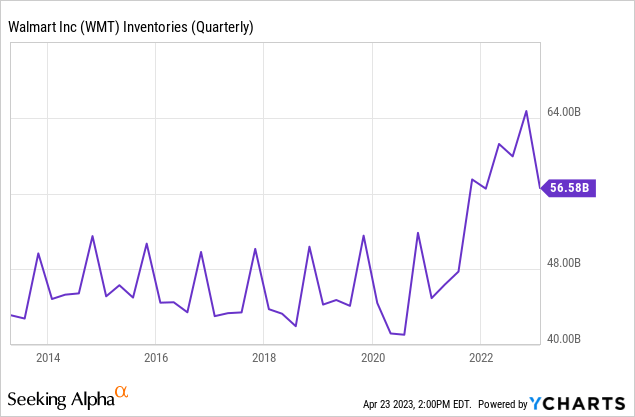
There is no certainty regarding the extent of further discounting needed to normalize inventory levels, which introduces an element of uncertainty to Walmart’s future financial performance. Concurrently, Walmart’s stock trades at a PE ratio of 35, which is approximately the average value it has traded for in the past couple of years. Considering the heightened risks associated with changing consumer behavior and an inventory surplus, some investors may prefer purchasing Walmart stock at a lower price than its current valuation.
In terms of technical analysis, the emergence of an ascending broadening wedge and symmetrical broadening wedge signals significant uncertainty in the market. If the price corrects lower amid substantial volatility and successfully breaks the $116.47 level, this may initiate a downward trend in the market.
Conclusion
Based on the above discussion, it is evident from leading economic indicators that a recession is likely on the horizon. Walmart’s adaptability and commitment to maintaining low prices will be critical in retaining customer loyalty and fostering growth in an uncertain economic environment. The company’s investments in automation have positioned it to effectively compete against rivals and strengthen its market share. By embracing innovative technologies and adapting to changing consumer preferences, Walmart showcases its ability to thrive in challenging economic conditions and solidifies its status as a reliable choice for investors.
Furthermore, Walmart’s bullish price structure, supported by robust technical analysis and a history of resilience during recessions, highlights the company’s capacity to navigate difficult economic periods effectively. The stock’s potential to surpass previous all-time highs amid market volatility indicates that investors may consider purchasing the stock at current levels. The presence of an ascending broadening wedge and symmetrical broadening wedge signals significant market uncertainty and the potential for strong price movements. Nevertheless, the upward break of the inside bar suggests a likelihood of continued price increase.
In conclusion, it is crucial for investors to closely monitor market developments and adapt their strategies accordingly. Investors can consider buying Walmart’s stock at current levels to capitalize on future growth opportunities.
Editor’s Note: This article was submitted as part of Seeking Alpha’s Best Investment Idea For A Potential Recession competition, which runs through April 28. This competition is open to all users and contributors; click here to find out more and submit your article today!
Analyst’s Disclosure: I/we have no stock, option or similar derivative position in any of the companies mentioned, and no plans to initiate any such positions within the next 72 hours. I wrote this article myself, and it expresses my own opinions. I am not receiving compensation for it (other than from Seeking Alpha). I have no business relationship with any company whose stock is mentioned in this article.
Seeking Alpha’s Disclosure: Past performance is no guarantee of future results. No recommendation or advice is being given as to whether any investment is suitable for a particular investor. Any views or opinions expressed above may not reflect those of Seeking Alpha as a whole. Seeking Alpha is not a licensed securities dealer, broker or US investment adviser or investment bank. Our analysts are third party authors that include both professional investors and individual investors who may not be licensed or certified by any institute or regulatory body.
